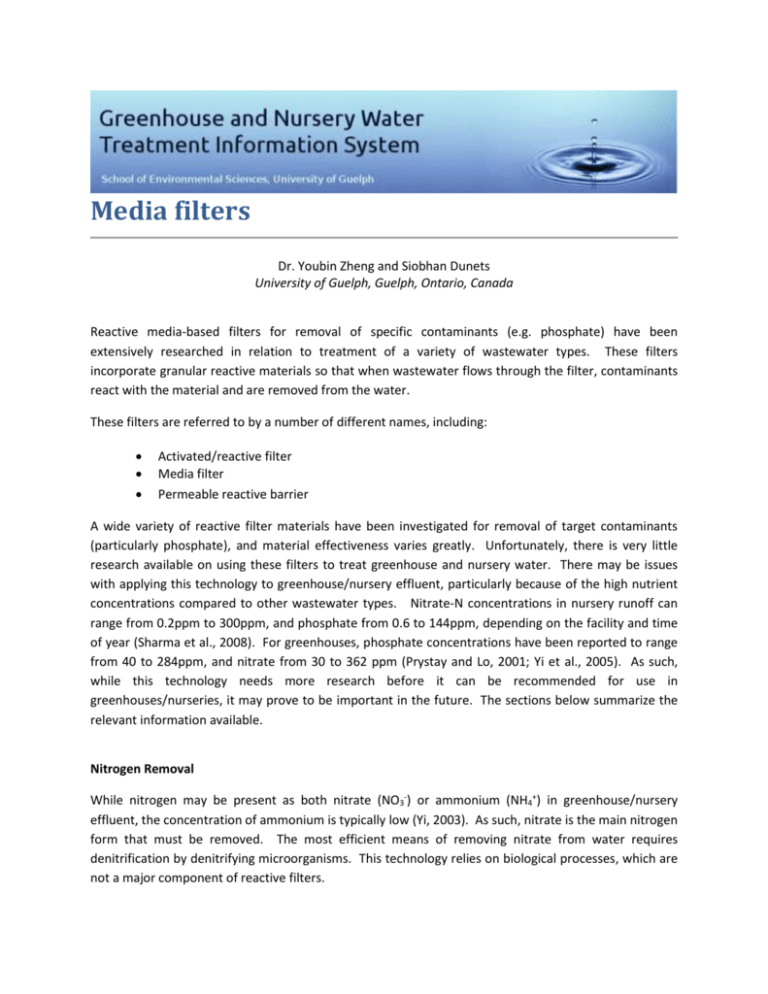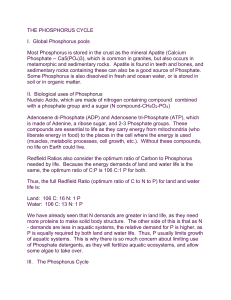Activated filters_final - Controlled Environment Systems
advertisement

Media filters Dr. Youbin Zheng and Siobhan Dunets University of Guelph, Guelph, Ontario, Canada Reactive media-based filters for removal of specific contaminants (e.g. phosphate) have been extensively researched in relation to treatment of a variety of wastewater types. These filters incorporate granular reactive materials so that when wastewater flows through the filter, contaminants react with the material and are removed from the water. These filters are referred to by a number of different names, including: Activated/reactive filter Media filter Permeable reactive barrier A wide variety of reactive filter materials have been investigated for removal of target contaminants (particularly phosphate), and material effectiveness varies greatly. Unfortunately, there is very little research available on using these filters to treat greenhouse and nursery water. There may be issues with applying this technology to greenhouse/nursery effluent, particularly because of the high nutrient concentrations compared to other wastewater types. Nitrate-N concentrations in nursery runoff can range from 0.2ppm to 300ppm, and phosphate from 0.6 to 144ppm, depending on the facility and time of year (Sharma et al., 2008). For greenhouses, phosphate concentrations have been reported to range from 40 to 284ppm, and nitrate from 30 to 362 ppm (Prystay and Lo, 2001; Yi et al., 2005). As such, while this technology needs more research before it can be recommended for use in greenhouses/nurseries, it may prove to be important in the future. The sections below summarize the relevant information available. Nitrogen Removal While nitrogen may be present as both nitrate (NO3-) or ammonium (NH4+) in greenhouse/nursery effluent, the concentration of ammonium is typically low (Yi, 2003). As such, nitrate is the main nitrogen form that must be removed. The most efficient means of removing nitrate from water requires denitrification by denitrifying microorganisms. This technology relies on biological processes, which are not a major component of reactive filters. Phosphorus Removal Activated filters targeted towards phosphate removal tend to remove phosphate via two processes: Adsorption: The attachment of phosphate to charged surfaces of filter materials (namely on iron and aluminum oxides) Precipitation/crystallization: negatively charged phosphate bonds with positively charged ions (namely calcium, iron, or aluminum) provided by the filter media, forming insoluble compounds A variety of filter materials have been investigated for phosphate removal. These materials typically have high calcium, iron, and/or aluminum content. Potential filter materials can be categorized into naturally-derived materials, industrial waste products, and manufactured materials. Naturally-occurring materials with phosphate removal properties include various rocks and minerals, such as: limestone (Shilton et al., 2005): common calcium-based, high-pH rock serpentinite (Drizo et al., 2006): magnesium-silicate mineral with deposits in Quebec crushed shells (Park and Polprasert, 2008): made up of CaCO3 and have high pH Industrial waste products (that is, by-products of industrial processes) that have been investigated for re-use as reactive filter media include: fly ash (Cheung and Venkitachalam, 2000): iron, aluminum, and silicon-rich, high-pH by-product of coal combustion. red mud (Liu et al., 2011): high-pH iron and aluminum based by-product of alumina production from bauxite steel slag (Baker et al., 1999): Iron and calcium-rich, high-pH, common by-product of iron and steel production; many types are available. This material has been shown to be especially promising and has received significant investigation. Light weight aggregates, produced by modifying natural clays to improve phosphate removal capacity through heating them to temperatures over 1000°C , have been developed specifically for the purpose of P removal from wastewater, including: Phoslock (produced in Australia) Filtralite P (produced in Norway) LECA (Scandinavian) Phosphate removal by all of these materials tends to reduce over time, likely as a result of adsorption capacity and cation content (for precipitation) being used up. The amount of phosphate that can be taken up by the material (usually expressed in g/kg) before it becomes saturated (and needs to be replaced) varies widely between materials, and even within material types (ie. depending on source, particle size, etc.). Phosphate removal capacity of a filter may also be affected by how long water is allowed to be in contact with the filter material, the phosphate concentration of the water being treated, or other factors such as temperature (Cucarella and Renman, 2009). Ultimately, the phosphate removal capacity of a filter material, in addition to the % of phosphate it can remove with each passthrough, will determine its viability for use. The reviews Vohla et al. (2009), Ballantine and Tanner (2010), and Cucarella and Renman (2009) can be consulted for more information on potential materials for P removal, and the comparative effectiveness of these materials. These reactive materials can also be incorporated into constructed wetlands as a substrate, in place of the typical inert gravel (provided their properties are suitable for supporting plant life). Ideally, when saturated with phosphate, the filter material could be recycled to provide fertilizer for plants on site or elsewhere (Bird and Drizo, 2009; Cucarella et al., 2008). This is important as phosphorus is non-renewable resource. A commercially available example of a phosphate-removing reactive media filter is the PhosphexTM System developed at the University of Waterloo (Waterloo, Ontario, Canada) (Phosphex, n.d.; Baker, 1998). This filter incorporates a by-product of the steel industry and limestone, so that phosphate removal occurs via precipitation and adsorption. However, the effectiveness of this filter has only been tested with removal of phosphate levels <10ppm, so suitability for treating higher-concentration greenhouse effluent is unknown. Very little research has looked at the viability of using reactive media filters to treat nursery or greenhouse wastewater for phosphate. White et al. (2011) found a calcined clay material incorporated in a wetland removed 60-74% of phosphate from a simulated nursery effluent containing 4.2 ppm phosphorus, over a course of seven months. It is possible that phosphate removal using media filtration may only be viable for some facilities. For facilities where phosphate concentration is very high (ex. >>20ppm; particularly common for hydroponic greenhouses), filter media may become saturated with phosphate very quickly and need to be replaced more frequently than is convenient (or financially viable), depending on how much wastewater is produced. In these situations, phosphate removal using precipitation or a fluidized bed reactor may be more appropriate. Our lab at the University of Guelph is currently conducting more research on phosphate removal, and the results will be available for growers shortly. Pesticides/other contaminants Toller and Flaim (1988) used a filter composed of organic materials (peat, moss, and manure) to remove pesticides via adsorption. The filter had >99% removal efficiency for 12 different fertilizers. Other compounds with a high adsorption capacity, such as clays (or clays with organic materials added) have been successful in retaining organic pesticides (Rodriguez-Cruz et al., 2007). REFERENCES Baker, M.J., Blowes, D.W., Ptacek, C.J. 1998. Laboratory development of permeable reactive mixtures for the removal of phosphorous from onsite wastewater disposal systems. Environmental Science and Technology 32: 2308–2316. Bird S and Drizo A. 2009. Investigations on phosphorus recovery and reuse as soil amendment from electric arc furnace slag filters. Journal of Environmental Science and Health A 44: 1476-1483. Ballantine DJ and Tanner CC. 2010. Substrate and filter materials to enhance phosphorus removal in constructed wetlands treating diff use farm runoff: A review. New Zealand Journal of Agricultural Research 53: 71–95. Cheung, K.C. and Venkitachalam, T.H. 2000. Improving phosphate removal of sand infiltration system using alkaline fly ash. Chemosphere 41: 243–249. Cucarella V and Renman G. 2009. Phosphorus sorption capacity of filter materials used for on-site wastewater treatment determined in batch experiments: A comparative study. Journal of Environmental Quality 38: 381–392. Cucarella T, Zleski T, Mazurek R, and Renman G. 2008. Effect of reactive substrates used for the removal of phosphorus from wastewater on the fertility of acid soils. Bioresource Technology 99: 4308–4314. Drizo, A., Forget, C., Chapuis, R.P., and Comeau, Y. 2006. Phosphorus removal by electric arc furnace steel slag and serpentinite. Water Research 40: 1547–1554. Liu Y, Naidu R, and Ming M. 2011. Red mud as an amendment for pollutants in solid and liquid phases. Geoderma 163: 1-12. Park WH and Polprasert C. 2008. Phosphorus adsorption characteristics of oyster shells and alum sludge and their application for nutrient control in constructed wetland system. Journal of Environmental Science and Health A. 43, 511–517. Prystay, W. and Lo, K. V. 2001. Treatment of greenhouse wastewater using constructed wetlands. Journal of Environmental Science and Health.Part B: Pesticides, Food Contaminants, and Agricultural Wastes 36: 341-353. Rodríguez-Cruz, M.S., Sánchez-Martín, M.J., Andrades, M.S., and Sánchez-Camazano, M. 2007. Modification of clay barriers with a cationic surfactant to improve the retention of pesticides in soils. Journal of Hazardous Materials B139: 363-372. Sharma, J., Wilson, P.C., and Yeager, T.H. 2008. Remediation of runoff: Options for container plant nurseries. University of Florida: IFAS Extension. Shilton A, Pratt S, Drizo A, Mahmood B, Banker S, Billings L, Glenny S, Luo D. 2005. ‘Active’ filters for upgrading phosphorus removal from pond systems. Water Science and Technology 51: 111–116. Toller, G. and Flaim, G. M. 1988. A filtering unit for the removal of pesticide residues from aqueous solutions. Water Research 22: 657-661. University of Waterloo. n.d. Phosphex. Retrieved from: http://www.research.uwaterloo.ca/watco/technologies/phosphex/index.htm Vohla C, Kõiv M, Bavor HJ, Chazarencc F, and Mander Ü. 2009. Filter materials for phosphorus removal from wastewater in treatment wetlands—A review. Ecological Engineering 37: 70-89 White SA, Taylor MD, Albano JP, Klaine SJ, and Whitwell T. 2011. Phosphorus retention in lab and fieldscale subsurface-flow wetlands treating plant nursery runoff. Ecological Engineering 37: 1968–1976.








